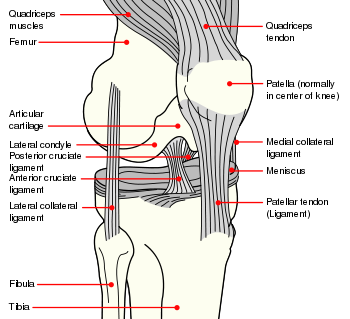Ligament
.
In anatomy, a ligament is a band or sheet of strong fibrous connective tissue that connects bones to other bones, or to cartilage, or supports an organ, such as the spleen, uterus, or eyeball. Sometimes known as articular ligaments, fibrous ligaments, or true ligaments, such structures tend to be somewhat flexible but inelastic. They differ from tendons in that tendons connect skeletal muscles to their attachments.
The term ligament also is used to denote two additional structures: a fold of peritoneum or other membrane, and the remnants of a tubular structure from the fetal period of life. This article will only briefly review these later two types of ligaments, with the article mainly focusing on the first meaning, which is what is most commonly meant by the term ligament.
The study of ligaments is known as desmology, from the Greek desmos (δεσμός), meaning "string," and -logia (-λογία), meaning "study of."
Articular ligaments
In its most common use, a ligament is a short band of tough fibrous dense regular connective tissue composed mainly of long, stringy collagen fibers. Ligaments connect bones to other bones to form a joint. (They do not connect muscles to bones; that is the function of tendons.) Some ligaments limit the mobility of articulations, or prevent certain movements altogether.
Capsular ligaments are part of the articular capsule that surrounds synovial joints. They act as mechanical reinforcements. Extra-capsular ligaments join bones together and provide joint stability.
Ligaments are only elastic; when under tension, they gradually lengthen. (Unlike tendons which are inelastic). This is one reason why dislocated joints must be set as quickly as possible: if the ligaments lengthen too much, then the joint will be weakened, becoming prone to future dislocations. Athletes, gymnasts, dancers, and martial artists perform stretching exercises to lengthen their ligaments, making their joints more supple. The term double-jointed refers to people who have more elastic ligaments, allowing their joints to stretch and contort further. The medical term for describing such double-jointed persons is hyperlaxity and double-jointed is a synonym of hyperlax.
The consequence of a broken ligament can be instability of the joint. Not all broken ligaments need surgery, but if surgery is needed to stabilise the joint, the broken ligament can be joined. Scar tissue may prevent this. If it is not possible to fix the broken ligament, other procedures such as the Brunelli Procedure can correct the instability. Instability of a joint can over time lead to wear of the cartilage and eventually to osteoarthritis.
Examples:
Knee
- Anterior cruciate ligament (ACL)
- Lateral collateral ligament (LCL)
- Posterior cruciate ligament (PCL)
- Medial collateral ligament (MCL)
- Cranial cruciate ligament (CrCL) - quadruped equivalent of ACL
- Caudal cruciate ligament (CaCL) - quadruped equivalent of PCL
Head and neck
- Cricothyroid ligament
- Periodontal ligament
- Suspensory ligament of the lens
Pelvis
- Anterior sacroiliac ligament
- Posterior sacroiliac ligament
- Sacrotuberous ligament
- Sacrospinous ligament
- Inferior pubic ligament
- Superior pubic ligament
- Suspensory ligament of the penis
Thorax
- Suspensory ligament of the breast
Wrist
- See Wrist#Ligaments
See also
- Joint
- Brostrom procedure
Peritoneal ligaments
Certain folds of peritoneum are referred to as ligaments.
Examples include:
- The hepatoduodenal ligament surrounds the hepatic portal vein and other vessels as they travel from the duodenum to the liver.
- The broad ligament of the uterus is also a fold of peritoneum.
- The suspensory ligament of the ovary
Fetal remnant ligaments
Certain tubular structures from the fetal period are referred to as ligaments after they close up and turn into cord-like structures:
| Fetal | Adult |
| ductus arteriosus | ligamentum arteriosum |
| extra-hepatic portion of the fetal left umbilical vein | ligamentum teres hepatis (the "round ligament of the liver"). |
| intra-hepatic portion of the fetal left umbilical vein (the ductus venosus) | ligamentum venosum |
| distal portions of the fetal left and right umbilical arteries | medial umbilical ligaments |
ReferencesISBN links support NWE through referral fees
- Blakemore, C., and S. Jennett. 2001. The Oxford Companion to the Body. New York: Oxford University Press. ISBN 019852403X.
Dorland, William Alexander Newman. 2007. Dorland's illustrated medical dictionary. Edinburgh: Elsevier Saunders. ISBN 9781416023647
http://www.mercksource.com/pp/us/cns/cns_hl_dorlands_split.jsp?pg=/ppdocs/us/common/dorlands/dorland/five/000059130.htm ligament
ligament (lig´ә-mәnt) a band of fibrous tissue connecting bones or cartilages, serving to support and strengthen joints. See also sprain.
a double layer of peritoneum extending from one visceral organ to another. cordlike remnants of fetal tubular structures that are nonfunctional after birth. adj.,
External links
| |||||||||||||||
| ||||||||||||||||||||||||||||||||||||||||
| ||||||||||||||
| |||||||||||||||||||||||||||||||||||||||||||||||||
| ||||||||||||||||||||
| |||||||||||
Credits
New World Encyclopedia writers and editors rewrote and completed the Wikipedia article in accordance with New World Encyclopedia standards. This article abides by terms of the Creative Commons CC-by-sa 3.0 License (CC-by-sa), which may be used and disseminated with proper attribution. Credit is due under the terms of this license that can reference both the New World Encyclopedia contributors and the selfless volunteer contributors of the Wikimedia Foundation. To cite this article click here for a list of acceptable citing formats.The history of earlier contributions by wikipedians is accessible to researchers here:
The history of this article since it was imported to New World Encyclopedia:
Note: Some restrictions may apply to use of individual images which are separately licensed.

